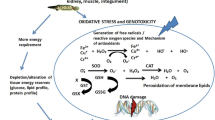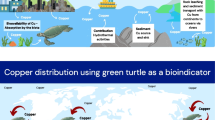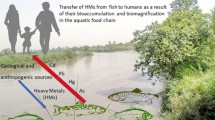Abstract
In this study, bioaccumulation of the heavy metals (Hg, Pb, Cd, Cu, Zn, Cr, Ni, Fe, Mn, V, Li, Al) in the shells of Mytilus edulis were investigated. Shells of Mytilus edulis were collected in May to September 2005 from 12 stations on the Polish coast of Baltic Sea. At each sampling sites 17–330 different size of shells were collected during 2005, respectively. Due to heavy industrial activities in the region, the bay has the polluted coastal waters of Poland. Shells were analysed by ICP AES and Coleman MAS 50 CV atomic absorption spectrometer. As expected from the similarity found between the relationships of metal content length and dry the concentrations of the different metals in the shells did not seem to depend on the shell length. No significant differences were detected in metal concentration between different shell lengths. Given their geographical distributions, as well as their abilities to show up spatial and temporal changes in metal bioavailabilities confirmed here, it is concluded that the mussel M. edulis a suitable candidate to be used in biomonitoring surveys of the Poland coast of Baltic.
Similar content being viewed by others
References
Al-Dabbas, M. A. M., Hubbard, F. H., & McManus, J. (1984). The shell of Mytilus as an indicator of zonal variations of water quality within an estuary. Estuarine, coastal and shelf science, 18, 263–270.
Amiard-Triquet, C., Berthet B., Metayer, C., & Amiard, J. C. (1986). Contribution to the ecotoxicological study of cadmium, lead, copper and zinc in the mussel Mytilus edulis: II. Experimental study. Marine Biology, 90, 7–13.
Bourgoin, B. P. (1990). Mytilus edulis shell as a bioindicator of lead pollution: Considerations on bioavailability and variability. Marine ecology. Progress series, 61(3), 253–262.
Boyden, C. R. (1977). Effect of size upon metal content of shellfish. Journal of the Marine Biological Association UK, 57, 675–714.
Brix, H., & Lyngby, J. E. (1985). The influence of size upon the concentrations of Cd, Cr, Cu, Hg, Pb and Zn in the common mussel (Mytilus edulis L.). Symposia Biologica Hungarica, 29, 253–271.
Brown, M. T., & Depledge, M. H. (1998). Determinants of trace metal concentrations in marine organisms. In W. Langston & M. J. Bebianno (Eds.), Metal metabolism in aquatic environments (pp. 185–217). London: Chapman & Hall.
Carell, B., Forberg, S., Grundelius, E., Henrikson, L., Johnels, A., Lindh, U., et al. (1987). Can mussel shells reveal environmental history? Ambio, 16, 2–10.
Carriker, M. R., Palmer, R. E., Sick, L. V., & Jonhson, C. C., (1980). Interaction of mineral elements in sea water and shell of oysters (Crassostrea virginica (Glemin)) cultured in controlled and natural systems. Journal of experimental marine biology and ecology, 46, 279–296.
Carriker, M. R., Swan, C. P., & Ewart, J. W. (1982). An exploratory study with the proton microprobe of the ontogenic distribution of 16 elements in the shell of living oysters (Crassostrea virginica). Marine Biology, 69, 235–246.
Chow, T. J., Snyder, H. G., & Snyder, C. B. (1976). Mussels (Mytilus sp.) as an indicator of lead pollution. Science of the total environment, 6, 55–63.
Cobelo-Garcia, A., Prego, R., & Labandeira, A. (2004). Land inputs of trace metals, major elements, particulate organic carbon and suspended solids to an industrial coastal bay of NE Atlantic. Water research, 38, 1753–1764.
Farrington, J. W., Goldberg, E. D., Risebrough, J. H., Martin, J. H., & Bowen, V. T. (1983). U.S “Mussel Watch” 1976–1978: An overview of the trace-metal, DDE, PCB, hydrocarbon and artificial radionuclide data. Environmental Science & Technology, 17, 490–496.
Ferrel, R. E., Carville, T. E., & Martinez, J. D. (1973). Trace metals in oysters shells. Environmental Letters, 4, 311–316.
Foster, P., & Chacko, J. (1995). Minor and trace elements in the shell of Patella vulgata (L.). Marine Environmental Research, 40, 55–76.
Foster, P., Chacko, J., & Badran, M. (1997). Minor and trace metal concentrations in the shells of four Nerita species (N. albicilla, N. costata, N. polita, N. undata) from Ko Phuket, Thailand. J Mar Atmos Res, 1, 25–32.
Giusti, L., Williamson, A. C., & Mistry, A. (1999). Biologically available trace metals in Mytilus edulis from the coast of northeast England. Environment international, 25(8), 968–981.
Goldberg, E. D., Bowen, V. T., Farrington, J. W., Harvey, G., Martin, J. H., Parker, P. L., et al. (1978). The mussel watch. Environmental conservation, 5, 101–125.
Goldberg E. D, Koide M., Hodge V., Flegal A. R., & Martin J., (1983). U.S. mussel watch: 1977–1978 results on trace metals and radionuclides. Estuarine, Coastal and Shelf Science, 16, 69–93.
Hovgaard, P., Mortensen, S., & Strand, Ø. (2001). Skjell – biologi og dyrking. 1. Ed. Kystnæringen Forlag & bokklubb AS, 2001. 255 pp.
Ikuta, K., & Szefer, P. (2002). Distribution of heavy metals in soft tissue and shell of Astarte borealis and Macoma balthica from Supsk Furrow, a southern Baltic (in press).
Knutzen, J., & Skei, J. (1990). Quality criteria for micropollutants in water, sediment and organisms and preliminary proposals for classification of environmental quality NIVA-report, I.nr. 2540 (139). Oslo, Norway: NIVA
Koide, M., Lee, D. S., & Goldberg, E. D. (1982). Metal and transuranic records in mussel shells, byssal threads and tissues. Estuarine, Coastal and Shelf Science, 15, 679–695.
Krishnakumar, P. K., Casillas, E., & Varanasi, U. (1994). Effects of environmental contaminants on the health of Mytilus edulis from Puget Sound, Washington, USA. I. Cytochemical measures of lysosomal responses in the digestive cells using automatic image analysis. Marine Ecology. Progress Series, 106, 249–261.
Krishnakumar, P. K., Casillas, E., & Varanasi, U. (1995). Effects of environmental contaminants on the health of Mytilus edulis from Puget Sound, Washington, USA. II. Cytochemical detection of subcellular changes in the digestive cells. Marine Biology, 124, 251–259.
Latouche, Y. D., & Mix, M. C. (1982). The effect of depuration, size and sex on trace metal levels in bay mussels. Marine Pollution Bulletin, 13, 27–29.
Lauenstein, G. G., Robertson, A., & O’Connor, T. P. (1990). Comparison of trace metal data in mussels and oysters from a Mussel Watch programme of the 1970s with those from a 1980s programme. Marine Pollution Bulletin, 21, 440–447.
Lingard, S. M., Evans, R. D., & Bourgoin, B. P. (1992). Method for the estimation of organic-bound and crystal-bound metal concentrations in bivalves shells. Bulletin of Environmental Contamination and Toxicology, 48, 179–184.
Linnaeus, C. (1758). Systema naturae per regna tria naturae, secundum classes, ordines, genera, species, cum characteribus, differentiis, synonymis, locis. Tomus I. Editio decima, reformata. pp. [1–4], 1–824. Holmiae. (Laurentii Salvii).
Neumann, T., Leipe, T., Brand, T., & Shimmield, G. (1996). Accumulation of heavy metals in the Oder Estuary and its off-shore basins. Chemie der Erde, 56, 207–222.
Phillips, D. J. H. (1976). The commen mussel Mytilus edulis as an indicator of pollution by zinc, cadmium, lead and copper. I. Effects of environmental variables on uptake of metals. Marine Biology, 38, 59–69.
Phillips, D. J. H. (1977). The common mussel Mytilus edulis as an indicator of trace metals in Scandinavian waters I: zinc and cadmium. Marine Biology, 43, 283–291.
Phillips, D. J. H. (1978). The common mussel Mytilus edulis as an indicator of trace metals in Scandinavian waters. II. Lead, iron and manganese. Marine Biology, 46, 147–156.
Phillips, D. J. H. (1980). Quantitative aquatic biological indicators. London: Applied Science.
Phillips, D. J. H., & Rainbow, P. S. (1993). Biomonitoring of trace aquatic contaminants (p. 371). London: Elsevier Applied Science.
Prakash, N. T., Rao, K. S. J., Sivasankaran, M. A., Reddy, S. S., & Naidu, T. S. (1996). Metal content in the shells of green mussel, Perna viridis (L.) from east coast of India: A preliminary study. Journal of Aquatic Biology, 11(1–2), 24–30.
Price, G. D., & Pierce, N. J. G. (1997). Biomonitoring of pollution by Cerastoderma edule from the British Isles: A laser ablation ICP-MS study. Marine pollution bulletin, 34(12), 1025–1031.
Puente, X., Villares, R., Carral, E., & Carballeira, A. (1996). Nacreous shell of Mytilus galloprovincialis as a biomonitor of heavy metal pollution in Galiza (NW Spain). Science of the Total Environment, 183(3), 205–211.
Rainbow, P. S. (1995a). Biomonitoring of heavy metal availability in the marine environment. Marine Pollution Bulletin, 31, 183–192.
Rainbow, P. S. (1995b). Physiology, physicochemistry and metal uptake in crustacean perspective. Marine Pollution Bulletin, 31, 55–59.
Rainbow, P. S. (1997). Ecophysiology of trace metal uptake in crustaceans. Est. Cstl. Shelf Sci., 44, 169–175.
Rainbow, P. S., & Phillips, D. J. H. (1993). Cosmopolitan biomonitors of trace metals. Marine Pollution Bulletin, 26, 593–601.
Rhoads, D. C., & Lutz, R. A. (1980).Skeletal growth of aquatic organisms. London: Plenum.
Richardson, C. A., Chenery, S. R. N., & Cook, J. M. (2001). Assessing the history of trace metal (Cu, Zn, Pb) contamination in the North Sea through laser ablation ICP-MS of horse mussel Modiolus modiolus shells. Marine Ecology. Progress Series, 211, 157–167.
Ridgwig, J., Breward, N., Langston, W. J., Lister, R., Rees, J. G., & Rowlatt, S. M. (2003). Distinguishing between natural and anthropogenic sources of metals entering the Irish Sea. Applied Geochemistry, 18, 283–309.
Seed, R. (1976). Ecology. In B. L. Bayne (Ed.), Marine mussels; their ecology and physiology (pp. 13–65). Cambridge: Cambridge University Press.
Seed, R. (1992). Systematics, evolution and distribution of mussels belonging to the genus Mytilus: An overview. Amer. Malacol. Bull., 9, 123–137.
Soto, M., Ireland, M. P., & Marigo´mez, I. (1997). The contribution of metal/shell-weight index in target-tissues to metal body burden in sentinel marine molluscs. 2. Mytilus galloprovincialis. Science of the Total Environment, 198(2), 149–160.
Soto, M., Kortabitarte, M., & Marigo´mez, I. (1995). Bioavailable heavy metals in estuarine waters as assessed by metal/shell-weight indices in sentinel mussels Mytilus galloprovincialis. Marine Ecology. Progress Series, 125(1–3), 127–136.
Sturesson, U. (1976). Lead enrichment in shells of Mytilus edulis. Ambio, 5, 253–256.
Sturesson, U. (1978). Cadmium enrichment in shells of Mytilus edulis. Ambio, 7, 122–125.
Szefer, P. (1986). Some metals in benthic invertebrates in Gdansk Bay. Marine Pollution Bulletin, 17, 503–507.
Szefer, P., & Szefer, K. (1985). Occurrence of ten metals in Mytilus edulis L. and Cardium glaucum from the Gdansk Bay. Marine Pollution Bulletin, 16, 446–450.
Szefer, P., & Szefer, K. (1990). Metals in molluscs and associated bottom sediments of the southern Baltic. HelgolaÉnder Meeresuntersuchungen, 44, 424–441.
Zatsepin, V. I., Filatova, Z. A., & Shilejko, A. A. (1988). Klass Dwustworchatyie molljuski (Bivalvia). In R. K. Pasternak (Ed.), Zhizn’Zhivotnyh-Molljuski-Iglokozie-Chlenistonogie (The Life of Animals-Mollusc) (pp. 65–112.) Moscow: Prosveshchenie, Izdatelstvo (in Russian).
Author information
Authors and Affiliations
Corresponding author
Rights and permissions
About this article
Cite this article
Protasowicki, M., Dural, M. & Jaremek, J. Trace metals in the shells of blue mussels (Mytilus edulis) from the Poland coast of Baltic sea. Environ Monit Assess 141, 329–337 (2008). https://doi.org/10.1007/s10661-007-9899-4
Received:
Accepted:
Published:
Issue Date:
DOI: https://doi.org/10.1007/s10661-007-9899-4




